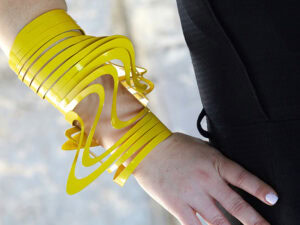The Dragon Is Dead
In olden times, we believed in supernatural forces. A stray look from a stranger would be enough to induce a panic that we had fallen victim to the evil eye. These phenomena had no rational explanation, so could not be controlled by normal means. Instead, they required the intervention of magical devices, such as amulets and talismans, to combat their powers.
The Dragon Is Dead
In olden times, we believed in supernatural forces. A stray look from a stranger would be enough to induce a panic that we had fallen victim to the evil eye. These phenomena had no rational explanation, so could not be controlled by normal means. Instead, they required the intervention of magical devices, such as amulets and talismans, to combat their powers.
Fortunately, we escaped such superstitions. We now take responsibility for our own fate. We confront our fears with scientific evidence and if that doesn’t work, we take ourselves off to therapy. Avoiding the cracks on the pavement or believing in lucky numbers may be indulged in childhood, but with adult status comes the need to trust in more reliable sources of guidance, such as education and news media. Superstitions are amusing, even a little nostalgic, but we simply can’t afford to trust in wishful thinking.
Yet despite all this rationality, we do still continue to find ways of enchanting our world. The elves and fairies of the past now take a more secular form. Where there was magic, now there are brands. Consumer products radiate a mystical aura that charges our world with possibility. Anticipated by feverish speculation, Steve Jobs appears like an oracle to reveal the new iThing that will open yet another dimension to the celestial world of the screen. With each new cloud application, Google conjures a god-like world consciousness, bridging space and time.
But The Tiger Lives On
Why do we cling to enchantment? Despite the rising tide of managerialism, there are still aspects of our lives that cannot be controlled. We can feel well qualified for a job, but being selected for it will depend on the other candidates and the whims of the interview panel. The time and place of natural phenomena like lightning, earthquakes and firestorms are impossible to predict in advance. And we know with climate change that we will face uncertain weather futures even if we manage to reduce greenhouse gas emissions.
Thankfully, we have stories that make sense of this uncertainty. Without uncertainty, our lives would be dull and predictable. Life would be devoid of interesting stories. All the best travel tales come from mishaps – missed connections, lost luggage, mistranslations . . . Stories feed off luck and luck reminds us of our common fallibility.
There will always be luck, even in a world without magic. But it gets harder to share. You won’t find it on an iPhone app or Google search. Luck is a pre-technological, anti-digital platform. Luck is the thread we construct that binds our life experience into story form.
From A Distant Land
While there are certain routines, sometimes even rituals, that are seen to favor luck, it is the real tangible object that offers greatest power. The being of the object exerts a stronger effect than a mere action such as casting a spell. But for the object to work, it cannot be an ordinary thing readily available in everyday life. To buy a toothbrush from a supermarket and then claim it as a lucky charm is about as plausible as proposing marriage on a crowded bus.
Just as luck is something that we cannot control, so the object that provides it must be something rare and difficult to access. It is almost as though it selected us, rather than we it. The exotic source can be refer to where it comes from, such as a piece of rock that exists in only one location. Or it can be what has been done it, such as an object blessed by a religious leader.
The Light That Glows in the Shadows
Unlike most other forms of jewelry, a lucky charm is not usually made to be displayed. It is at home in a relatively private location, such as underneath clothing. Privacy serves two functions. First, it creates a sense of intimacy with the object and thus touches on those personal feelings such as fear that we try not to disclose in public. Second, it saves the wearer having to account for it to curious others, which can wear the mystery down with exposure.
Possible locations include:
- Around the neck and kept under shirt or blouse
- Slipped into wallet
- In a pocket
- Underside of finger ring
This privacy need not be a static condition. Proximity helps in bringing the object discretely within reach to be touched, fondled or ‘worried.’ Ideally, the object has a tactile affordance that invites physical contact, such as a variation of texture or contour. The tactile sensation provides a mnemonic ‘string’ that connects different events together along the same narrative thread. Neuronal pathways can form around this string on which the traffic of our fears and hopes can flow.
Beyond touch, there may be a special phrase that is either visible on the object or associated with the object by the wearer. In this case, such a phrase can be recited as a source of inner support, or guidance at a moment of concern.
So when should a charm be activated?
The Lightning, Not the Sunlight
Life can be roughly divided into two forms – routine and change. Most of our life is spent in mundane tasks, of whose outcome we are reasonably certain. We catch a bus from home to work. We clean the house. We sit through a work meeting. Most of the time, we more or less know what the outcome is going to be. It is a matter of chugging through what needs to be done.
But there are moments of change. While we no longer commemorate them with secret rituals, the major rites of passage are still significant – birth, coming of age, marriage, childbirth and death. It is at times like these when we realise that life is a force essentially beyond individual control and we turn to larger structures, like religion or tribal identity. Modernity has brought with it new rites of passage, such as final school examinations, graduation, first overseas trip, buying a home, sitting job interviews, promotion and retirement. They shape us more than we them.
But there are also less public events that can have an equally significant bearing on our lives. There are idiosyncratic moments like a blind date, writing an essay, buying a pet – all of which open the door of possibility. And there are personally quite momentous experiences that remain hidden from others, particularly those associated with illnesses like cancer, while we undergo the ordeal of chemotherapy and sit in waiting rooms bracing ourselves for the specialist to convey the results of tests. Will our life be full or cut short?
A charm can be particularly powerful if it picks up on one of these fateful threads in our life and helps structure a continuity as we ride the bumps of contingency. While we await with trepidation the next turn of events, we can made contact with our charm and think of the road that has lead us to this path. Even if things go awry and our hopes are dashed, at least we have the sense of journey to sustain us. We have a witness.
Harness the Tiger
While a lucky charm has potential to give meaning regardless of its efficacy, depending on how we use it, there is one contingency where bad luck does lead to an irreversible tragedy – we lose the charm itself. The charm isn’t like a digital photo that we can store away in some virtual cloud. It is a hapless material thing that can be broken, lost, stolen or destroyed.
What happens when the singular object that was holding your life together by a critical thread disappears? The best you can do it to find a new charm that will pick up the thread and try to find ways of integrating into your life.
Not all threads continue to our end. A sportsperson will eventually retire from the game. We may eventually win that battle against cancer. There comes a time when the lucky charm will not be needed.
If the charm has been effective, then it has accrued its own power. Now that it has completed its task, the charm can be passed on to someone else. The story of its personal significance to you then perfectly completes the cycle by providing a new owner with the mysterious and unique origin important to its success.
But now this charm has made its imprint in your life, you might like to find ways of holding on to it. You might like to design a symbol from it that become a personal sign. The wishbone charm that assisted your struggle through tertiary education then becomes the logo of the publishing house that you later establish.
The Eagle Learns To Walk
So why this article in a site for contemporary jewelry? At first glance, the artistic nature of contemporary jewelry seems an ill-fitting platform for a charm. Luck isn’t readily channeled through the artistic project of a creative and skilled jewelry artist. That’s seems too self-conscious a context to channel unknown forces.
But maybe there are other ways of being creative as a jeweler – closer to design than art. Jewelers know by experience the kind of attachment that people can have to their work. They have the skill to create the kind of tactile affordances that can ingratiate an object into our lives.
What’s missing is the story of its origin. This attends to an element of design that is often implicit, but rarely credited compared to fashion and utility. Design theorists such as Stuart Walker are increasingly talking about the symbolic dimension of design. For jewelers it offers a use for knowledge they already have, which is the importance for the client of the story of the object – not just where it came from, but also where it is going.




